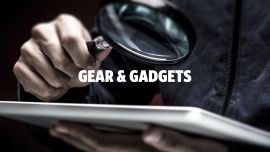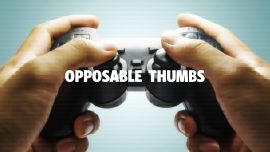00:00
Right now at the beginning of this year,
00:01
one out of every five homes had Nintendo.
00:03
By the end of this year, one out of every three homes
00:05
in America will have Nintendo.
00:07
That's how fast it's growing.
00:08
How long did it take you to get blinking again after that?
00:10
I don't know. [laughing]
00:11
You look at yourself, you realize you're a zombie
00:13
staring into that screen, playing.
00:14
It's scary stuff. Unbelievable.
00:16
[digital musical motif]
00:18
One time the salesperson said they went in
00:21
to talk about the terms of the sale
00:23
and that someone [laughing] pulled a gun out of their drawer
00:27
and set it on the table in front of them
00:30
to show them how serious they were about not taking a risk.
00:35
Was definitely a rough chapter.
00:42
I was the advertising manager for Nintendo in 1985.
00:46
And this is how I helped bring the NES to America.
00:51
[light hip hop music]
01:00
When I started at Nintendo, July 11th, 1983, 7-11,
01:05
it was really a arcade game company,
01:08
but also we did Game & Watch, little handheld games.
01:12
My favorite one was called Flagman.
01:15
We also had some tabletop games.
01:17
They looked like mini arcade games.
01:19
So right after I started,
01:21
I had my first trip to New York to work with Dentsu,
01:25
our ad agency back there
01:27
and make a commercial for Mario's Cement Factory.
01:32
At the time, I think there were about 70 people
01:34
at Nintendo of America, in a way.
01:37
It was a very, very small group.
01:40
Famicom came out, not too long after that.
01:44
We were focused on, I think, Donkey Kong 3 arcade game,
01:47
right when I started.
01:49
But in Japan, they launched the Famicom.
01:53
We got to see the games, which were really exciting
01:56
'cause they seem like they looked like the same quality
01:59
we had in the arcade.
02:00
Of course, the design changed when it became the NES.
02:05
It was really awesome from the beginning.
02:08
So in 1985, we were dealing with the situation
02:14
that the video game market had just crashed.
02:17
There was really a lot of oversupply at retail.
02:21
And so things were being heavily discounted.
02:24
You would just walk through the mall
02:25
and see these bins of closeouts of cartridges
02:28
that consumers were really seeming to say
02:31
that they were tired of it,
02:32
that the games maybe didn't have enough diversity
02:34
between different games.
02:36
The over promising of the marketing
02:39
was leading to things like ET came out
02:42
and there was this huge folklore or urban legend
02:45
that when it came out, that there was so much oversupply
02:49
that it ended up going into a landfill
02:52
somewhere in New Mexico.
02:53
But actually I think not too long ago,
02:56
someone actually dug them up to prove that it was true.
03:00
And the retailers really had suffered
03:03
from over investing in inventory and oversupply.
03:08
And so the whole market just kind of had collapsed.
03:11
It was at that point that we were trying to reenter
03:15
with what we thought was clearly a better product,
03:19
really coming in at a time when both the consumers
03:22
and the retailers felt like video games
03:25
had been a fad and it was kind of over.
03:27
So our approach to kind of coming back
03:30
into the home video market was,
03:34
we decided to launch in New York only.
03:37
Kind of biggest city,
03:39
if-you-can-make-it-there type of thing.
03:41
So we started in September of 1985
03:46
in New York only, and really focused on a deluxe system
03:51
that had the zapper and it had ROB the Robot
03:55
before finally rolling out nationally
03:59
in the end of '86, or Holiday '86.
04:02
And at that time, when we launched nationally,
04:05
we also had a Base Set, which included Mario
04:09
and the Deluxe Set that we originally had.
04:11
So ultimately we took advantage of that killer app
04:14
with Mario for the national launch.
04:17
Every game and the hardware came with this big poster.
04:23
And surrounding it was a screenshot of every game
04:26
divided into categories.
04:28
We kept that poster in there for a long time,
04:32
till probably the initial library
04:34
had 15 titles plus the pack ins.
04:38
Until we probably had over 30 titles,
04:41
we continued to put that in.
04:42
Another element that we put in was a card
04:46
that actually emphasized the quality seal
04:49
and that Nintendo guaranteed the quality of the product
04:53
from both an entertainment value
04:55
and the workmanship of the product.
04:58
That quality seal at the time, my boss, Ron Judy
05:01
he's like, What could we do that would be more like
05:04
the Good Housekeeping Seal of Approval?
05:07
And that Nintendo Quality Seal,
05:09
it still appears on every box and on licensed products
05:13
from lunchboxes to whatever.
05:16
So that is something that stayed with Nintendo.
05:20
So when the NES launched,
05:22
the launch titles being Duck Hunt and Gyromite.
05:27
Those games were fun.
05:28
Certainly took advantage of the accessories.
05:31
And Mario was definitely a killer app.
05:34
I really liked NES Golf
05:35
'cause I had played that in the arcade version,
05:38
but I also liked a little kind of puzzle type game
05:42
called Clu Clu Land.
05:43
Another game with a sunglass wearing polar bear
05:46
called Ice Climber.
05:48
A lot of people love Clu Clu Land.
05:49
Clu Clu Land, where are you?
05:52
[light hip hop music]
05:57
When it came to trying to find out
05:59
what you as consumers would think about the NES,
06:03
we did a few different focus groups.
06:07
I would sit behind the mirror
06:08
and I was the only one who knew how to play.
06:10
So I would have to come out
06:12
and demonstrate the product to the kids.
06:14
And the kids were age range from 8 to 12 or 8 to 14.
06:21
They seemed interested, like they wanted to see.
06:24
They wanted to see me demo the robot
06:27
or the zapper and seemed to me, they were happy and excited.
06:33
And then we went to New Jersey and one of those sessions,
06:37
the Nintendo executive team came
06:40
and watched from behind the glass as well.
06:45
Did the same thing. And the kids are reacting.
06:48
And some kid who was very unruly,
06:51
he drew a picture of a joystick
06:52
that looked like a penis and held it up to my face
06:55
on the mirror, he said, I know you're behind here.
06:59
[laughing] Anyway, so the Nintendo executives come,
07:02
they're watching the kids,
07:03
the kids seem enthused, et cetera.
07:05
And at the end they ask the moderator
07:08
what he thinks about the chances for success.
07:12
And he said, kids are always enthusiastic about a product.
07:18
So that's not the best way to gauge it.
07:21
And they said, well,
07:23
what should we imagine that our success is?
07:25
He said, well, I've never seen anyone go ahead and launch
07:29
with this type of result.
07:32
It was a little worrisome
07:35
that what we were interpreting as positive,
07:39
the moderator was interpreting as neutral at best.
07:43
When the NES came out, even in New York,
07:47
the retailers had really been burned
07:50
through all of the close outs of the prior generation.
07:53
So they were not very receptive to taking in the product.
07:57
And that really was probably one of the more difficult goals
08:02
was to get the retailers, to give it shelf space,
08:05
to have them not be concerned that they won't want to have
08:08
a lot of markdowns or be stuck with product
08:11
that they couldn't sell, that they had taken a risk on.
08:14
So it was really one of the bigger challenges
08:17
and trying to get them to include the NES
08:21
in our advertising for the holidays.
08:24
So the kinds of retailers
08:25
that we had to work with in the early days,
08:27
especially since what had happened in the prior generation,
08:32
a lot of toys stores and that type of retailer
08:36
were really concerned about working with video games.
08:41
So a lot of people these days
08:44
look at that iconic imagery,
08:45
the way that packaging is that looks old fashioned,
08:49
like pixels, like graph paper, the way we named things,
08:52
we made sure not to call it a video game system,
08:56
So when it came to these challenges
08:58
of trying to get away from the prior generation,
09:01
there were challenges as related to retail.
09:04
My challenges were more related to kind of make sure
09:07
that the consumer and the parents who were purchasing
09:11
didn't think that it was just more of the same.
09:15
A group of us went back, there was a group of five or six,
09:19
and then they brought like five more people back.
09:22
And, living in temporary apartments, that kind of thing
09:26
in New Jersey and renting cars and vans and running out
09:31
and trying to install these big ROB displays at retail
09:36
and to deliver product to them.
09:39
And there were times when, they went to the Bronx
09:43
with a truckload of product and a display.
09:46
While they're loading in the display,
09:48
people are looting the car, it was crazy.
09:53
And back in 1985, New York was much less safe
10:00
So, park the car, get the wheels taken off.
10:04
Not only was it difficult to get retailers
10:07
or businesspeople to take a risk
10:09
on putting a video game system and cartridges on the shelf.
10:14
But parents had seen that they bought these games
10:19
for their kids and they didn't even play them.
10:22
Parents thought, I am not spending more money
10:25
on a video game when you play it for 10 minutes
10:29
and then you're not interested.
10:32
We felt like we really did have a better product,
10:36
a product that wouldn't disappoint.
10:38
And we've wanted to put all efforts into making sure
10:42
the consumer felt like they got their money's worth
10:45
and that they would want to buy another game
10:48
when we introduced more software.
10:54
Some of the things that we did to that end
10:57
were we called it the Nintendo Entertainment System.
11:01
And the advertising really focused
11:03
on the whole family playing together.
11:06
It's looks pretty corny today, but it's a 1980s family
11:10
and the dad is playing,
11:12
and the mom is excited about playing, and two kids.
11:16
And that type of advertising and positioning
11:20
was the way that we went.
11:22
Also putting ROB the Robot first
11:25
in the sale of the NES or Nintendo Entertainment System,
11:30
really gave a point of differentiation
11:33
and made it look like it was more futuristic.
11:37
And I think we also want to make sure
11:39
that we would depend on the bug factor,
11:42
which we called kids bugging their parents to get it,
11:46
but that the parent would see that this was something
11:49
that truly was new and different
11:52
and would be a good investment for the whole family.
11:55
I think in the early days,
11:57
making sure that we weren't associated
12:00
with what had gone on before, that these video games
12:04
that were just simple blips
12:06
and used a lot of licenses like ET,
12:08
like other major sports or movies, entertainment.
12:14
They would have a picture from the actual movie,
12:17
a real person playing tennis on the cover.
12:20
And then you would open
12:22
and it would just basically be advanced Kong.
12:25
You'd look at the package and then you would play the game
12:28
and it'd be a complete disconnect.
12:31
So at the time the packaging that we created
12:35
to make sure people didn't experience disappointment
12:39
between the trimmings, if you will, and the actual software
12:44
was really made on graph paper.
12:47
It was supposed to represent computer graphics.
12:51
It's quite blocky and it's kind of iconic today.
12:54
People really see it as retro, but the whole purpose was
12:58
that we didn't want to show, beautiful illustrations
13:03
or photographs of real things on the packaging
13:07
and then have people say, this game is nothing like this.
13:12
So if anything, we kind of undersold
13:16
in order to continue with this consumer satisfaction need
13:21
and not wanting to ever disappoint.
13:24
So all kids seemed enthusiastic to us
13:26
in the focus groups, but the experts told us
13:29
not to expect too much.
13:32
We used that in thinking, jeez,
13:34
we really are going to have to make sure
13:37
that they think that we present this as new and different
13:41
things like calling the games, game packs
13:44
and the entertainment system.
13:47
And coming up with ROB, your Robotic Operating Buddy.
13:51
We had a lot of the nomenclature,
13:54
anything just from the idea of using the word cartridge
13:57
was something we didn't want to use.
13:59
So we really tried to come up with ways
14:01
about demonstrating and visually representing the product
14:06
that was going to make them understand
14:09
that this wasn't what they had seen before.
14:11
So one of the tactics we used to make sure
14:14
kids could get their hands on the system
14:17
and actually see it and experience it,
14:19
that it was something new and different
14:21
was we did grassroots marketing at mall tours.
14:26
So we booked these malls around the greater New York area.
14:31
And we would go in and set up on Friday night
14:34
and through the weekend we would have the system set up
14:38
and interesting cabinets, and a big screen,
14:42
which at the time like a 40 big screen was a big deal.
14:46
Little platform and a big screen.
14:49
And on the big screen, we would play NES Baseball.
14:53
And we had some stars from the Mets
14:56
come out and play against the kids.
15:00
So they would create a line and get to step up and play.
15:04
And so the two celebrities
15:07
that we were able to contract with, one was Ron Darling
15:10
from the Mets who was really a Playboy kind of guy,
15:16
at the time was very well known and did a lot of promotion.
15:20
And another guy named Mookie Wilson,
15:22
And Mookie had a son named Preston,
15:24
and he would also come to the mall tour.
15:27
So sometimes he was the most enthusiastic kid
15:30
and he probably also know how to play the games,
15:32
the best of anybody by the time we were done.
15:35
But I remember going to a mall out in Long Island
15:40
where the mall manager, she just didn't want us there.
15:45
So she put us like in the basement, in the corner.
15:48
And she, and I had an all out war over,
15:52
we had booked this promotion,
15:54
but she didn't want anything to do with video games
15:57
and the negative influence that they would have.
16:01
So she wanted to hide us in the corner.
16:05
But it was a way of getting out there
16:06
and getting people to see it and play it
16:08
and see that it was better than a generation before.
16:13
And it certainly worked in terms of
16:15
kids definitely wanted to ask for it for Christmas.
16:18
And hopefully parents liked it too,
16:20
and saw that it would be fun.
16:23
So the team that was back in New York,
16:25
because it was pretty small, I think in total,
16:27
there might've been 10 or 12 people,
16:29
but when we got to the weekend
16:30
that we were going to actually launch
16:32
and the product was going to go out to retail,
16:36
night that it came in and we were ready to go.
16:39
We had Ron Judy and Bruce Lowry was the VP of sales,
16:45
Mr. Arakawa our president and Howard Lincoln, our senior VP
16:49
were all back there with us and we loaded up the truck
16:54
in the warehouse and opened a bottle of champagne
16:57
that we drank out of styrofoam cups. [laughing]
17:00
And we were in New Jersey.
17:02
And off went the truck for delivery.
17:05
So the next morning, a few of us went
17:07
and stood outside of the FAO Schwarz.
17:09
The system was all set up.
17:11
And we waited for people to come in
17:13
and make that first sale.
17:14
So someone comes in and they not only buy the system,
17:16
but they buy like every game. And it was so excite-
17:20
I was like, oh, they're, they're buying it,
17:22
they're buying it. You know?
17:25
Later we found out that it was like a Japanese publisher
17:29
who came in and bought it for samples for their business.
17:33
Later, after New York, we went to LA
17:37
and we use those same tactics.
17:40
We were starting to prepare
17:42
for how we were going to do a national launch.
17:44
It's tough 'cause we were a pretty lean team.
17:48
And at the time a guy named Don Kingsborough
17:51
had launched a company called Worlds of Wonder
17:54
with Teddy Ruxpin was their big product line.
17:58
And he was someone that we knew from the business.
18:01
And Mr. Arakawa really liked him.
18:04
And he and Ron Judy talked to Don about,
18:07
maybe there was a way that we could use
18:10
their distribution process
18:13
to get our products into stores nationwide.
18:16
At the time, there were a lot of regional chains
18:20
as opposed to national chains that we have now,
18:22
like Target or Walmart, that kind of thing.
18:25
We decided to use their rep firm.
18:29
And we went to a meeting, I believe it was before a CES.
18:32
And we went to this meeting to introduce them to the product
18:35
and show them what it was like.
18:37
And I know I was demoing the product
18:40
and that they were gonna have this big opportunity
18:42
to add this Nintendo line along with Teddy Ruxpin
18:47
to take out to retailers.
18:50
And many of them had also already been through the fall
18:54
of the video game industry and how challenging it was
18:57
when all the accounts want to return the product
18:59
or deal with markdowns, et cetera,
19:01
they were not enthusiastic.
19:04
And they were actually downright disrespectful
19:07
during the meeting.
19:08
And so Don [indistinct], he got up
19:12
and he essentially yelled at them about their disrespect.
19:17
This whole sales team of like 50 people in this room
19:22
are basically saying, [laughing]
19:23
we don't want to sell your product.
19:25
But they went on to, of course, have great success.
19:29
And many of them stayed with Nintendo
19:32
after Worlds of Wonder wasn't really in business anymore.
19:36
Or the Teddy Ruxpin fad was over.
19:38
They continued to have a good business
19:40
with Nintendo for many years.
19:47
Since my job was marketing communications,
19:50
doing things like advertising, PR, trying to get stories,
19:55
that was very difficult.
19:56
Trying to get stories about Nintendo.
20:03
We even did an event in LA
20:05
where we had a whole bunch of kids celebrities come,
20:08
like at the time Jason Bateman
20:10
was a kid celebrity and his sister.
20:14
And we had all these people, Wil Wheaton
20:18
from Stand By Me at the time.
20:20
And even with that type of what we considered
20:23
kid starpower, we had a hard time
20:27
getting pickup on public relations,
20:29
getting people to talk about it.
20:30
As we launched nationally,
20:35
it became something where you would see it
20:38
in your personal life.
20:39
I think you feel the success when, as a regular consumer,
20:45
you walk into a store
20:46
and you really see your work right there.
20:48
It's on the screen.
20:51
It just legitimizes it so much.
20:53
And it made me feel like not only were we successful,
20:57
but it was gonna be a big thing
20:58
and that it was gonna be around a long time.
21:01
So once we launched nationally with the NES,
21:05
the company was really growing and started changing.
21:09
The marketing department went from two or three people
21:13
to dividing into different departments
21:16
and having many more layers, people with more experience.
21:22
We ended up forming our publishing division
21:25
and I got asked to move and start Nintendo Power Magazine,
21:29
which was an outgrowth of the Fun Club Newsletter.
21:35
We decided to make a full fledged magazine.
21:39
But there were other things that changed also.
21:42
At the senior level, Ron Judy left
21:44
and went to start Nintendo in Europe.
21:47
And Peter Main came on board.
21:49
He was a seasoned marketer
21:51
that Mr. Arakawa knew from Canada.
21:53
Bob Thompson, that I mentioned,
21:55
our customer service department, became huge.
21:59
And we founded Game Counseling, Customer Service.
22:02
And we had hundreds of people in that area.
22:06
Areas like licensing.
22:09
When we started licensing other companies to make software,
22:12
that area was incredibly important to Nintendo.
22:17
And to support that we had have a huge testing group
22:20
that would test all the games
22:22
and make sure the content met Nintendo's criteria,
22:27
and made sure that the programs themselves
22:29
didn't have any bugs or any glitches in them.
22:33
So that became a huge group of people.
22:36
So, really during the mid and late '80s,
22:40
the company really grew.
22:43
Maybe it just started looking a lot more
22:45
like a lot of other companies, but definitely
22:50
it grew by leaps and bounds at that time.
22:55
So along with all of the pack ins, at some point
22:59
we shifted to offering a newsletter
23:03
and it grew so quickly,
23:05
people wanting to get this newsletter,
23:07
that by the time we had the issue
23:09
called the Punch-Out!! issue,
23:11
we had about 600,000 subscribers.
23:15
So it was eating up a lot of marketing budget
23:18
to mail out this newsletter, create it, print it, mail it.
23:23
And Mr. Arakawa had seen that in Japan,
23:27
publishing about video games had grown
23:31
and become its own kind of category.
23:33
And he wanted to do that in the US too.
23:36
So he asked me if I would consider
23:40
taking on this publishing world
23:44
as a director of publications.
23:46
Then we started Nintendo Power
23:48
working with a co-publisher in Japan
23:51
who really understood how to take things like screenshots
23:56
and make all those cool maps
23:58
to show people how to play the games.
24:02
That was a really fun role for me.
24:05
Nintendo Power continued for, I think, almost 25 years.
24:10
So with Nintendo Power, one of the big purposes
24:13
was to make sure, again, that people liked the games,
24:17
make sure that they were satisfied
24:20
and they would always be ready to buy the next game,
24:23
felt it was worth their money.
24:24
So we would show a walk through of the whole game
24:28
in Nintendo Power or a Player's Guide.
24:31
But there was one policy which was,
24:33
you don't show the final boss or the final scene.
24:37
And the reason is, and I think I recall
24:40
that Mr. Miyamoto was a big driver of this
24:43
was that's the payoff for all your hard work.
24:46
You spent all this investment of playing this game
24:50
and getting to the end.
24:52
And to not let the consumer and the player
24:57
really enjoy the success of that final moment,
25:01
it was felt like, let's just keep that for them.
25:05
So when I think of the influenced Nintendo had on people,
25:09
probably the area that I am most proud of
25:12
is when you think of Nintendo Power
25:15
and the millions of readers of Nintendo Power,
25:19
the idea that we were actually getting kids to read
25:22
and getting them to study these things like these maps
25:27
and the detail, and to take something
25:29
that they loved as much as playing the game
25:32
and then want to really learn about it.
25:34
So just think how much you have to learn
25:36
when you're playing a game and how much
25:40
people enjoyed reading and poring over these things.
25:47
a mindset amongst those people
25:51
who were involved at that time as players,
25:53
as kids that was hopefully really valuable
25:58
and their whole life to think
26:00
if they wanted to know about something,
26:02
they would go read about it, or study about it.
26:04
And that they knew that they could expand their knowledge
26:09
through additional information and learning.
26:14
that's the coolest contribution from my side.
















